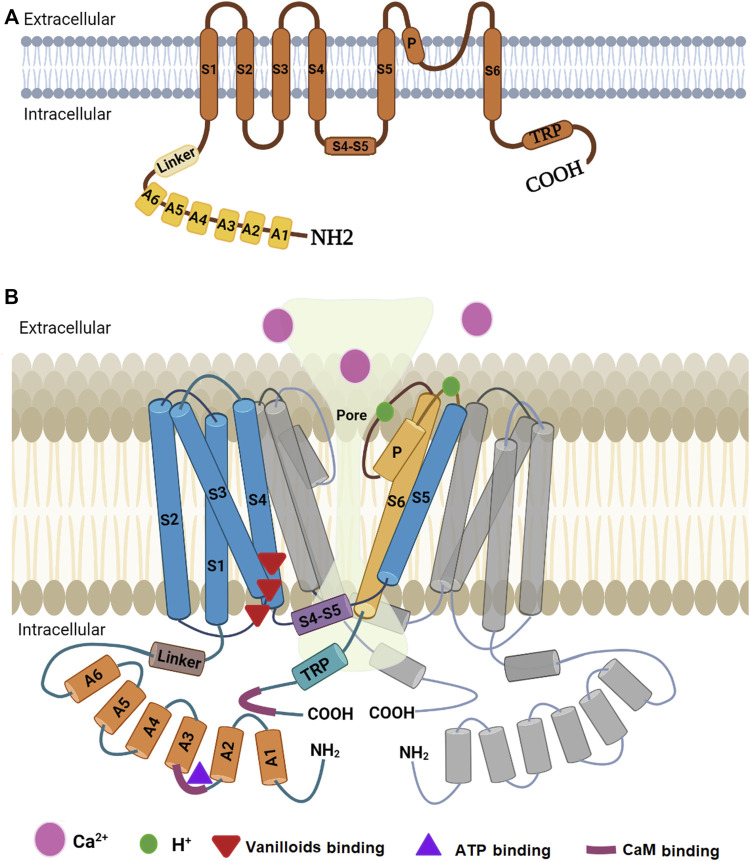
Transient receptor potential vanilloid 1 (TRPV1) is a ligand-gated ion channel belonging to the TRPV subfamily of the transient receptor potential (TRP) family. Activation of TRPV1 in the nervous system leads to cation influx, resulting in depolarization and action potentials in afferent neurons responsible for heat and pain sensations.
Read More...
Capsaicin, the active component in hot chili peppers, and various endogenous lipid molecules such as anandamide, are known to activate TRPV1. Due to this interaction, transient receptor potential vanilloid 1 is also known as the capsaicin receptor, as well as transient receptor potential cation channel subfamily V member 1, vanilloid receptor 1 (VR1), and Osm-9-like TRP channel 1 (OTRPC1).
TRPV1 is more selective towards cations than anions, but its ability to discriminate between small cations is poor. Its permeability for Ca2+ is generally higher than for Na+ and is dependent on the nature and concentration of the TRPV1 agonist. The TRPV1 receptor is composed of four subunits, forming a homotetramer with a broad extracellular opening and a brief selectivity filter. Its structure includes a variable N-terminal cytoplasmic region, a conserved linker region of approximately 70 residues, a transmembrane domain consisting of six membrane-spanning α helices (S1-S6), a lengthy pore-forming loop between S5 and S6, and a short cytoplasmic C-terminal region.

Figure 1. Structure of TRPV1. (A) One subunit showing the N-terminus containing six ankyrin subunits (A1-A6) and a linker, transmembrane region with six helical segments (S1-S6), a pore loop (P), and a C-terminus containing a TRP domain. (B) Two monomers of TRPV1 with a pore in the middle. One monomer (colored) is closer to the reader while the other (grey colored) is at 180°. The other two monomers have been omitted to show the pore.
Intracellular transient receptor potential vanilloid 1 possesses diverse roles in various physiological and pathological conditions. ER-localized TRPV1 activation, for example, leads to ER stress and pro-apoptotic pathways. Meanwhile, mitochondrial TRPV1 activation is involved in mitochondrial Ca2+ uptake, leading to mitochondrial depolarization and contributing to cell migration. TRPV1 presence in the Golgi apparatus suggests it is also involved in secretory pathway protein trafficking.
TRPV1 is present in the nervous system and in non-nerve tissues, including heart, liver, lung, kidney, adipose, and intestinal tissue, as well as skeletal muscle. It contributes to numerous physiological processes such as thermoregulation, circadian rhythms, energy intake, and lipid metabolism. Consequently, it has been studied extensively as a therapeutic target for pain, inflammation, and hyperlipidemia.
TRPV1 antibodies are designed to specifically bind to the TRPV1 receptor and are used in research as tools to selectively block or modulate the activity of TRPV1 receptors and influence downstream signaling pathways. TRPV1 antibodies can be utilized to investigate the functional role of TRPV1 in various biological processes, such as pain signaling, thermoregulation, and inflammation. Researchers use TRPV1 antibodies to visualize and study the localization and expression of TRPV1 receptors in tissues or to validate the presence of TRPV1 in experimental models. By using TRPV1 antibodies, researchers can identify the specific cells or regions expressing TRPV1, providing insights into the physiological or pathological roles of TRPV1 in different tissues and organs.
TRPV1 receptor agonists are compounds that activate the TRPV1 receptor, leading to the opening of ion channels and subsequent cellular responses. Capsaicin is a well-known natural TRPV1 agonist that is found in chili peppers. Activation by TRPV1 agonists leads to the transmission of pain signals to the central nervous system (CNS), which is responsible for the sensations of heat, burning pain, and inflammation associated with conditions such as thermal injury or exposure to capsaicin. Research utilizing TRPV1 agonists aims to understand the physiological and pathological functions of TRPV1, investigate pain mechanisms, and explore potential therapeutic applications.
TRPV1 antagonists or blockers are compounds that bind to the TRPV1 receptor and inhibit its activation by preventing the binding of TRPV1 agonists. TRPV1 antagonists effectively block the transmission of pain signals mediated by TRPV1, providing analgesic effects. TRPV1 blockers have been explored as potential treatments for chronic pain conditions, such as neuropathic pain and inflammatory pain. In research, TRPV1 blockers are used to study the role of TRPV1 in pain pathways, assess the therapeutic potential of blocking TRPV1 receptors, and investigate potential side effects or limitations of TRPV1 blockage.
TRPV1 products are vital tools for research that aims to understand the role of TRPV1 in various biological processes. Alomone Labs offers a range of TRPV1 products, including TRPV1 antibodies, agonists, activators, antagonists, blockers, and research packs, providing everything you need for TRPV1 research.
Immunodetection
Pharmacology
When Pain Aids Cancer
Recent findings explain how …
2023 © Alomone Labs. All Rights Reserved.

